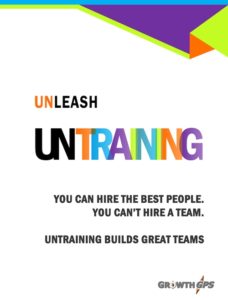I’m a lifelong runner. And whether racing or training, when I want to increase my speed there are only two options: I can try to pick up my pace by taking quicker steps, or I can try to lengthen my stride by covering more ground with each step. But these two methods conflict with each other. When I quicken my pace it’s more difficult to take bigger strides, and when I lengthen my stride it’s harder to take faster steps.
A similar conflict exists with how a business handles its relationship with a customer. Customers create value for a business in two different ways: They buy more today, or they improve their disposition toward you and buy more tomorrow. But for a business these two types of value are in conflict just like pace and stride are in conflict for a runner. The harder you work to “sell” a customer on today’s offering, the more likely you are to wear out your welcome and erode the customer’s willingness to buy in the future.
The problem facing many businesses today, is the focus on short-term results that blinds them to creating long-term value. They are unable to see this conflict for what it is – a trade-off. Companies find it easy to count each period’s sales and profits, but they often fail to quantify future sales and profits based on improving a customer’s willingness to buy in the future.
But that calculation can be done – it’s just a bit more difficult. In economic terms, the financial value of future cash flows attributable to a customer is the customer’s lifetime value (“LTV”). So when a business improves a customer’s predisposition to buy in the future, or to recommend the business to other customers, it increases the customer’s LTV. The increase in a customer’s LTV from today’s better customer service or going the extra step as a trusted resource, is real economic value created today. But the cash effect of that increase won’t be realized until sometime in the future.
Another way to think about it is to visualize the cost of bad service. Suppose a good customer calls you with a complaint, and for some reason your firm doesn’t handle the complaint very well, so at the end of the call this valuable customer slams the phone down in disgust. Didn’t your firm just lose a little bit of its economic value, as a going business?
Economically, the value of your business is the net present value of the future cash flow it will generate, and your future cash flow is likely to be somewhat less now, as this customer buys less, and likely tells his friends or colleagues about his experience with your firm as well.
So the event that destroyed this economic value occurred today, with the customer’s phone call, but the actual cash effect won’t be realized until some point in the future. And therein lies the problem for most businesses.
If you don’t make some attempt to measure your customers’ lifetime values, and to try to understand today’s events that cause these values to increase or decrease, your business is doomed to live perpetually in the world of short-termism. Competitively you’ll be prey to other companies that take a longer-term view of their business, and try to strike a balance that generates both kinds of value.
Customer relationships are the most direct link between short-term financial results and long-term company value. If you want help developing improved long-term value and profits, Growth GPS’ Customer Cultivation initiative offers solutions to enhance your pace and stride. Learn more or call us today 1-248-513-4799.


